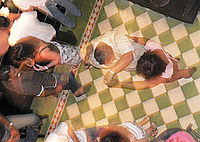Salsa Dance
http://en.wikipedia.org/wiki/Salsa_(dance)
The History of Salsa Dancing Part 3 – From Mambo To Salsa
Part 3 of a educational series I’m doing on the history of salsa dancing. This third video talks about how Mambo eventually came to be called salsa. It also summarizes the evolution of salsa from it’s African origins to modern day America. http://www.nysalsa101.com.
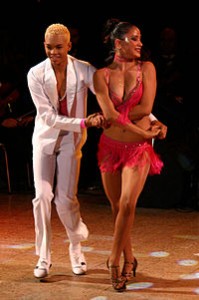 Salsa dancers Kevin and Sarahi dancing
Salsa dancers Kevin and Sarahi dancing
Salsa is a dance form with origins from the Cuban Son (circa 1920s) and Afro-Cuban dance (specifically Afro-Cuban Rumba (dance). It is generally associated with the salsa music style, although it may be danced under other types of music with an 8-count rhythm.
In many styles of Salsa dancing, as a dancer changes weight by stepping, the upper body remains level and nearly unaffected by the weight changes. Weight shifts cause the hips to move. Arm and shoulder movements are also incorporated. The Cuban Casino style of Salsa dancing involves significant movement above the waist, with up-and-down shoulder movements and shifting of the ribcage.
The arms are used by the “lead” dancer to communicate or signal the “follower,” either in “open” or “closed” position. The open position requires the two dancers to hold one or both hands, especially for moves that involve turns, putting arms behind the back, or moving around each other, to name a few examples. In the closed position, the leader puts the right hand on the follower’s back, while the follower puts the left hand on the leader’s shoulder.
In the original Latin America form, the forward/backward motion of Salsa is done in diagonal or sideways with the 3-step weight change intact.
 In some styles of salsa, such as LA and New York style, the dancers remain in a slot or line (switching places), while in some Latin American styles, such as Cuban style, the dancers circle around each other, sometimes in 3 points. This circular style is inspired by Cuban Son, specifically to the beat of Son Montuno in the 1920s. However, as it is a popular music, it is open to improvisation and thus it is continuously evolving. New modern salsa styles are associated and named to the original geographic areas that developed them. There are often devotees of each of these styles outside of their home territory. Characteristics that may identify a style include: timing, basic steps, foot patterns, body rolls and movements, turns and figures, attitude, dance influences and the way that partners hold each other. The point in a musical bar music where a slightly larger step is taken (the break step) and the direction the step moves can often be used to identify a style.
In some styles of salsa, such as LA and New York style, the dancers remain in a slot or line (switching places), while in some Latin American styles, such as Cuban style, the dancers circle around each other, sometimes in 3 points. This circular style is inspired by Cuban Son, specifically to the beat of Son Montuno in the 1920s. However, as it is a popular music, it is open to improvisation and thus it is continuously evolving. New modern salsa styles are associated and named to the original geographic areas that developed them. There are often devotees of each of these styles outside of their home territory. Characteristics that may identify a style include: timing, basic steps, foot patterns, body rolls and movements, turns and figures, attitude, dance influences and the way that partners hold each other. The point in a musical bar music where a slightly larger step is taken (the break step) and the direction the step moves can often be used to identify a style.
Incorporating other dance styling techniques into salsa dancing has become very common, for both men and women: shimmies, leg work, arm work, body movement, spins, body isolations, shoulder shimmies, rolls, even hand styling, acrobatics and lifts.
Latin American styles originate from Cuba and surrounding Caribbean islands.
Salsa Dancing Locations
Salsa dances are commonly held in night clubs, ballrooms, restaurants, and outside, especially if part of an outdoor festival. Salsa dancing is an international dance that can be found in most metropolitan cities in the world. Festivals are held annually, often called a Salsa Congress, in various host cities aimed to attract variety of salsa dancers from other cities and countries. The events bring dancers together to share their passion for the dance, build community, and to share moves and tips with each other. These events usually include salsa dance performers, live salsa music, workshops, open dancing, and contests.
Rhythm
Music suitable for dancing ranges from about 150 bpm (beats per minute) to around 250 bpm, although most dancing is done to music somewhere between 160–220 bpm. Every Salsa composition involves complex Afro-Cuban percussion based around the Clave Rhythm (which has four types), though there can be moments when the clave is hidden for a while, often when quoting Charanga, Changüí and Bomba. The key instrument that provides the core groove of a salsa song is the clave. It is often played with two wooden sticks (called clave) that are hit together. Every instrument in a Salsa band is either playing with the clave (generally: congas, timbales, piano, tres guitar, bongos, claves (instrument), strings) or playing independent of the clave rhythm (generally: bass, maracas, güiro, cowbell). Melodic components of the music and dancers can choose to be in clave or out of clave at any point. However it is taboo to play or dance to the wrong type of clave rhythm (see salsa music). While dancers can mark the clave rhythm directly, it is more common to do so indirectly (with, for example, a shoulder movement). This allows the dancing itself to look very fluent as if the rest of the body is just moving untouched with the legs.
There are other aspects outside of the Clave that help define Salsa rhythm: the cowbell, the Montuno rhythm and the Tumbao rhythm.For salsa, there are four types of clave rhythms, the 3-2 and 2-3 Son claves being the most important, and the 3-2 and 2-3 Rumba claves. Most salsa music is played with one of the Son claves, though a Rumba clave is occasionally used, especially during Rumba sections of some songs. As an example of how a clave fits within the 8 beats of a salsa dance, the beats of the 2-3 Son clave are played on the counts of 2, 3, 5, the “and” of 6, and 8.
The cowbell is played on the core beats of Salsa, 1, 3, 5 and 7. The basic Salsa rhythm is quick, quick, slow, quick, quick, slow, in other words, 1, 2, 3, 5, 6 and 7, which are very similar to the beats of the cowbell. Recognizing the rhythm of the cowbell helps one stay on Salsa rhythm.
The Montuno rhythm is a rhythm that is often played with a piano. The Montuno rhythm loops over the 8 counts and is useful for finding the direction of the music. By listening to the same rhythm, that loops back to the beginning after eight counts, one can recognize which count is the first beat of the music.
Tumbao is a rhythm in salsa that is played with the conga drums. It sounds like: “cu, cum.. pa… cu, cum… pa”. Its most basic pattern is played on the beats 2, 3, 4, 6, 7, and 8. Tumbao rhythm is helpful for learning to dance contra-tiempo (“On2”). The beats 2 and 6 are emphasized when dancing On2, and the Tumbao rhythm heavily emphasizes those beats as well.
Styles
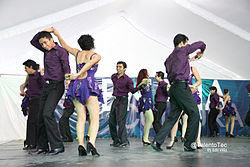 Students from Monterrey Institute of Technology and Higher Education, Mexico City perform at Culture Week
Students from Monterrey Institute of Technology and Higher Education, Mexico City perform at Culture Week
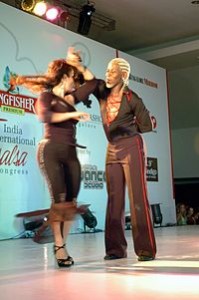 International Salsa Congress, 2004 at Bangalore
International Salsa Congress, 2004 at Bangalore
Salsa’s roots are based on Cuban Son, specifically to the beat of Son Montuno in the 1920s. However, as it is a popular music, it is open to improvisation and thus it is continuously evolving. New modern salsa styles are associated and named to the original geographic areas that developed them. There are often devotees of each of these styles outside of their home territory. Characteristics that may identify a style include: timing, basic steps, foot patterns, body rolls and movements, turns and figures, attitude, dance influences and the way that partners hold each other. The point in a musical bar music where a slightly larger step is taken (the break step) and the direction the step moves can often be used to identify a style.
Incorporating other dance styling techniques into salsa dancing has become very common, for both men and women: shimmies, leg work, arm work, body movement, spins, body isolations, shoulder shimmies, rolls, even hand styling, acrobatics and lifts.
Latin American styles originate from Cuba and surrounding Caribbean islands including Puerto Rico, and the Dominican Republic and then expanding to Venezuela, Colombia, and the rest of Latin America; also heavily influence “Miami” style which is a fusion of Cuban style and North American version. The styles include “Casino”, Miami-Style, Cali-style and Venezuelan Style.
North American styles have different characteristics: Los Angeles style breaks on the first beat “On 1” while New York style breaks on the second beat “On 2”. Both have different origins and evolutionary path, as the New York Salsa is heavily influenced by Jazz instruments in its early growth stage.
Colombian / Cali style
Cali-Style Salsa, also known as Colombian Salsa, is based on geographical location of the Colombian City of Cali. Cali is also known as the “Capital de la Salsa” (World’s Salsa Capital); due to salsa music being the main genre in parties, nightclubs and festivals in the 21st century.
The elements of Cali-Style Salsa were strongly influenced by dances to Caribbean rhythms which preceded salsa, such as Pachanga and Boogaloo.
The basic steles is the footwork which has quick rapid steps and skipping motions. They do not execute Cross-body Leads or the “Dile Que No” as seen in LA/New York-style and Cuban-style salsa, respectively. Their footwork is intricate and precise, helping several Colombian Style dancers win major world championships. Cali hosts many annual salsa events such as the World Salsa Cali Festival and the Encuentro de Melomanos y Coleccionistas.
Cuban-style salsa, also known as Casino, is popular in many places around the world, including in Europe, Latin America, North America, and even in some countries in the Middle East. Dancing Casino is an expression of popular social culture; Cubans consider casino as part of social and cultural activities centering around their popular music. The name Casino is derived from the Spanish term for the dance halls, “Casinos Deportivos” where a lot of social dancing was done among the better off, white Cubans during the mid-20th century and onward.
Historically, Casino traces its origin as a partner dance from Cuban Son, fused with partner figures and turns. As with the Son, Danzon and Cha Cha Cha, it is traditionally, though less often today, danced “a contratiempo”. This means that, distinct from subsequent forms of salsa, no step is taken on the first and fifth beats in each clave pattern and the fourth and eighth beat are emphasised. In this way, rather than following a beat, the dancers themselves contribute in their movement, to the polyrythmic pattern of the music.
What gives the dance its life, however, is not its mechanical technique, but understanding and spontaneous use of the rich Afro-Cuban dance vocabulary within a “Casino” dance. In the same way that a “sonero” (lead singer in Son and Salsa bands) will “quote” other, older songs in their own, a “casino” dancer will frequently improvise references to other dances, integrating movements, gestures and extended passages from the folkloric and popular heritage. This is particularly true of African descended Cubans. Such improvisations might include extracts of rumba, dances for African deities, the older popular dances such as Cha Cha Cha and Danzon as well as anything the dancer may feel.
Miami-style Casino
 Developed by Cuban migrants to Florida and centered around Miami, this form of Cuban Salsa fused with American culture and LA Style. Major differp of Colombian Salsa is the “Atras” or “Diagonal”; breaking backwards diagonally instead of moving forwards and backwards as seen in the New York and L.A. Style. Dancers do not shift their body weight greatly as seen in other styles. Instead, dancers keep their upper body still, poised and relaxed while the feet execute endless intricacies. The dancer breaks mostly On1 (sometimes On3), with short measures of “4” instead of full “8” counts.
Developed by Cuban migrants to Florida and centered around Miami, this form of Cuban Salsa fused with American culture and LA Style. Major differp of Colombian Salsa is the “Atras” or “Diagonal”; breaking backwards diagonally instead of moving forwards and backwards as seen in the New York and L.A. Style. Dancers do not shift their body weight greatly as seen in other styles. Instead, dancers keep their upper body still, poised and relaxed while the feet execute endless intricacies. The dancer breaks mostly On1 (sometimes On3), with short measures of “4” instead of full “8” counts.
A major difference of Cali Style and the other styences of Miami-style Casino is that it is exclusively danced on the downbeat (On1) and has elements of shines and showstyle added to it, following repertoires of North American Styles.
Miami-style has many adherents, particularly Cuban-Americans and other Latinos based in South Florida.
In the 1950’s Salsa Rueda or more accurately Rueda de Casino was developed in Havana, Cuba. Pairs of dancers form a circle (“Rueda” in Spanish means “Wheel”), with dance moves called out by one person. Many of the moves involve rapidly swapping partners.
“Rueda de Cuba” is original type of Rueda, originating from Cuba. It is not as formal as Rueda de Miami and consists of about 30 calls. It was codified in the 1970’s.
“Rueda de Miami” originated in the 1980’s from Miami, is a formal style with many rules based on a mix, and is a hybridization of Rueda de Cuba & Los Angeles-style Salsa and dance routines that reflect American culture (e.g. Coca-cola, Dedo, Adios) which is not found in the traditional Cuban-style Rueda.
Los Angeles style
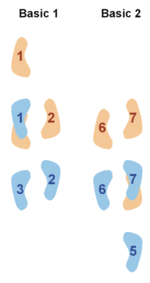 Basic step for LA-style, with leader’s steps in blue.
Basic step for LA-style, with leader’s steps in blue.
L.A. style is danced on 1, in a slot, with a measure of easiness and adaptability to it. It is strongly influenced by the Mambo, Swing, Argentine Tango and Latin Ballroom dancing styles. L.A. style places strong emphasis on sensuousness, theatricality, aerobics and musicality. The lifts, stunts and aerial works of today’s salsa shows are derived mostly from L.A. Style forms with origins in Latin Ballroom and Ballet lifts.
The two essential elements of this dance are the forward–backward basic as described above and the cross-body lead. In this pattern, the leader steps forward on 1, steps to the right on 2-3 while turning 90 degrees counter-clockwise (facing to the left), leaving the slot open. The follower then steps straight forward on 5-6 and turns on 7-8, while the leader makes another 90 degrees counter-clockwise and slightly forward, coming back into the slot. After these 8 counts, the leader and follower have exchanged their positions.
Albert Torres, Laura Canellias and Joe Cassini are credited for the early development and growth of L.A. Style Salsa. Later, such dancers as Alex Da Silva, Edie Lewis, Joby Martinez, Josie Neglia, Liz Rojas, Johnny and Francisco Vazquez and Janette Valenzuela are often credited with developing the L.A. style of Salsa Dancing as we know it today.
New York style
New York style is danced in a line similar to LA Style Salsa. However, unlike LA style, it is danced on the second beat of the music (“on 2”), and the follower steps forward on the first measure of the music, not the leader. The etiquette of New York Style is strict about remaining in the “slot” and avoiding traveling dancing in a sandbox area with a lot of spins, turns and styling. There is greater emphasis on performing “shines” in which dancers separate themselves and dance solo with intricate footwork and styling for a time—suspected origins from Swing and New York Tap.
Though he did not create New York style salsa, Eddie Torres is credited with popularizing it, and for having the follower step forward on the second beat of the first measure.
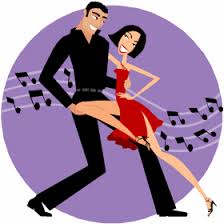 There are two distinct developments of New York Salsa as a music and dance genre:
There are two distinct developments of New York Salsa as a music and dance genre:
- Primary original evolution from Mambo era when Cuban music was introduced to New York due to influx of migrating Cuban dissidents and Latin migrants during Pre/Post Cuban Revolution in the 1950’s and 1960’s. This era is known as the “Palladium Era”. At this time, the music and dance was called “Mambo” or “Rhumba” — connoting the general term without being specific. The most famous dancer during this era was Puerto-Rican descendant Pedro “Cuban Pete” Aguilar, also known “The King of Latin Beat”.
- Secondary evolution during the late 1970’s, Latin migrants, particularly Puerto Ricans, contributed to the New York Salsa development during the “NuYorican” era of Héctor Lavoe which greatly popularized salsa as a term and modern Latin music throughout the world. Salsa superstars were “discovered” during the era, such as Ray Baretto (“The Godfather”) and Celia Cruz (“The Queen of Salsa”). There are also salsa artists that transcend both periods, notably the legendary Puerto Rican Tito Puente (“The Mambo King”).
These two developments create a fusion of a new salsa music and dance genre, different than its Latin American and L.A. Style counterparts.
New York style salsa emphasizes harmony with the percussive instruments in salsa music, such as the congas, timbales, and clave, since many or all of those instruments often mark the second beat in the music.

